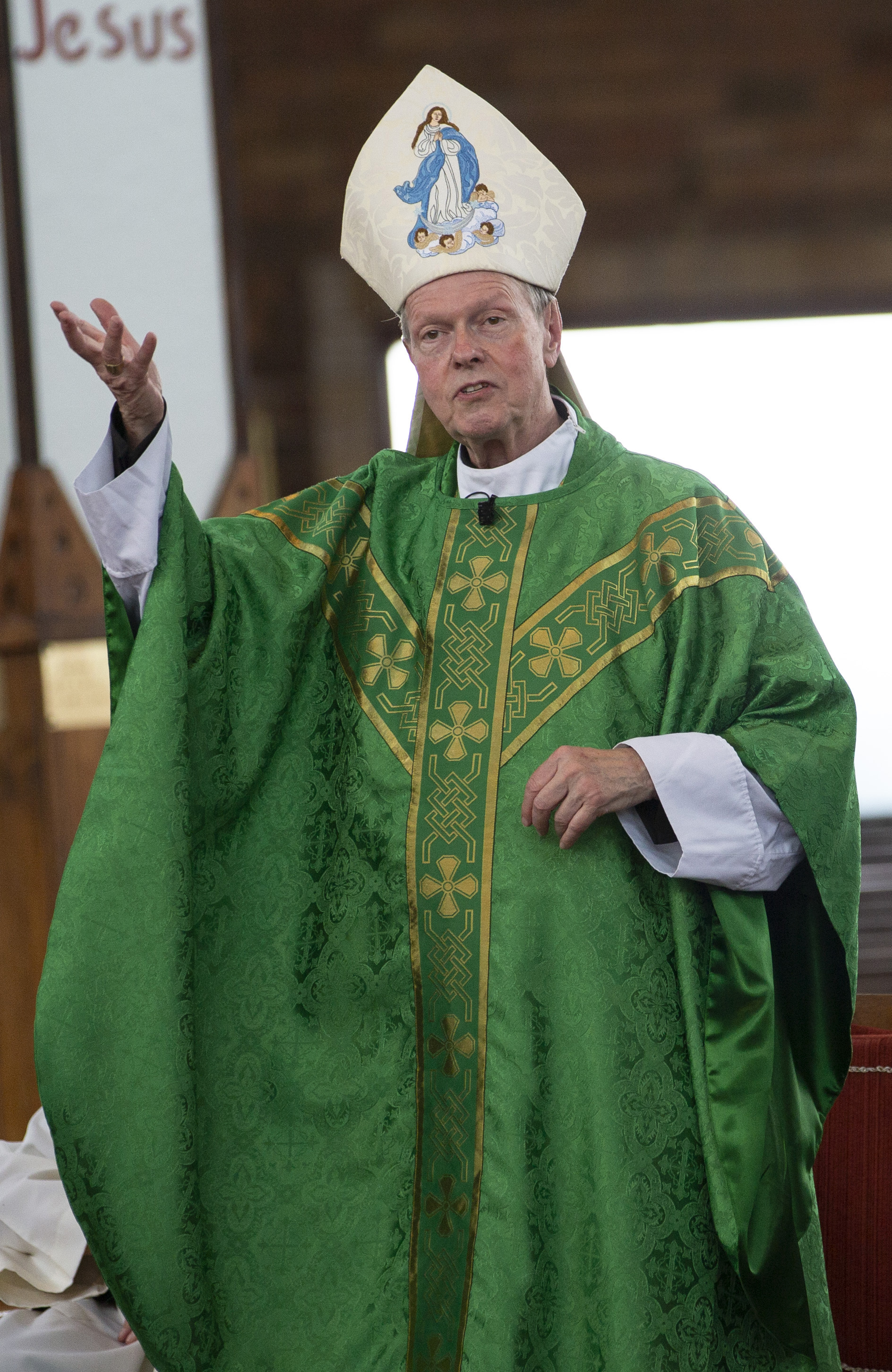April 6, 2018 at 1:53 p.m.
SPLIT COMMUNITY
Catholics take concrete stands on cement plant along Hudson
Five years into the process of bringing a controversial cement plant into Columbia County, Catholics are still divided over the environmental impact -- and basic propriety -- of the undertaking.
St. Lawrence Cement -- a Canadian company owned by Holnam, Inc., of Switzerland -- owns 2.8 square miles of land just south of the city of Hudson, in the town of Greenport. In 1998, the company proposed to develop that land into a new cement plant that would replace the one they currently operate in Catskill.
The proposal sparked an immediate controversy and a rapid polarization of ideas in Columbia County communities that would feel the effects -- whatever they may be -- of development.
Two sides
Opposition to the plant is spearheaded by a group known as Friends of Hudson, whose 3,800 members argue that the coal-burning operation would adversely affect the health of county residents and would construct an unsightly 400-foot smokestack.
According to organization president Mark Pratt, that stack would expel "greenhouse gases, fine particulate matter, heavy metals, arsenic, lead, and mercury" into the atmosphere.
Other residents advocate for the plant's construction, saying that advances in technology have made such plants cleaner and safer than they were 50 years ago. They contend that the new cement plant would help revitalize a flagging economy and bring fresh workers to the area. They note that Hudson was built on such industries, and that a new SLC plant would add to the tax base.
Dueling signs
The result has been an all-out struggle that has lead to entire neighborhoods pockmarked with signs; spirited, angry and heated arguments among neighbors in churches, barbershops and workplaces; aldermen, council members and higher governmental officials in disagreement; and even, at particularly sensitive times, people attempting to avoid sitting next to "people of a different opinion" at church on Sunday, according to one parishioner of St. Mary's Church in Hudson who declined to be named.
Columbia County Catholics are involved with advocacy for both viewpoints. Mayor Richard Scalera of Hudson is a St. Mary's parishioner and stands by his original estimation that "economically speaking, [the plant] will be a plus for this particular area. If [New York State's Department of Environmental Conservation] determines that this particular plant will be safe, I have to believe that, based on their expertise and knowledge, the plant will be safe."
In the middle
Priests say it's not their place to take sides on the St. Lawrence issue and maintain that their parishes need to be open to welcome all.
"A parish can't afford to polarize that way," said Rev. Gary Gelfenbein, pastor of St. James Church in Chatham. "They are the ones who live here. This is their community. We come in as pastors for a certain amount of time to be with them, serve them and work with them."
Rev. Winston Bath, pastor of St. Mary's Church in Hudson, notes that "there are people who feel very strongly about both sides in the parish."
Signs of dispute
One of the most visible signs of the conflict are the placards -- depicting the legends "Stop the Plant" and "Support the Plant" -- that have become ubiquitous in the yards, road signs and windows of Columbia County.
One opposing sign is planted firmly in the lawn belonging to St. James parishioner Constance Mondel, who believes that the scale of the operation -- intended to be up to three times bigger than the Catskill plant -- more than makes up for any new environmental safeguards that may be in place.
"I just don't believe it," she said of the defense of the plant. "If this goes forward, it will depress the area. We're not against industry, but it should be a lighter industry."
The "unsightly" plant, she added, may also hurt tourism and recreational river use, which have been on the rise of late. She worries that a docking area for large cement barges will make use of an adjoining riverfront park difficult.
"We're not developing a Disneyland here; we're developing the largest cement plant in the country," Mrs. Mondel argued. "I don't consider that an attraction. We don't need this plant."
Emissions
Last year, Hudson residents were given something else to consider: an independent panel of doctors at Columbia-Greene Hospital decided 34 to 1 that plant emissions due to burning coal as fuel may pose a problem for locals.
"We concluded that [the plant] is going to increase the risk of certain respiratory and heart diseases, and cancer," said Dr. Stewart Kaufman, president of the medical staff at the hospital.
Columbia County already has the highest incidence of cancer in New York State, although the cause has not been proven.
Worries
Ghent resident Pati Lanphear, a teacher's aide and St. James parishioner, is a cancer survivor. Her child has asthma. While she said her suspicions are "all hypothetical," she is concerned that heavy industry has played a part in the development of those sicknesses.
"I'm very concerned about the air our children will be breathing," she said.
But as a sign of the split in the county, her husband, Darin, disagrees; he believes those concerns are "being blown way out of proportion."
Mr. Lanphear, who teaches sixth-grade religious education class at his parish, said that he's "never heard of anyone dying from working in a cement plant. Everyone's concerned about the Hudson River. The existing plant is right on the Hudson River! Do they want to come up the river and see a whole cement plant, or do they want to see a single stack?"
Faith's role
Religious concerns play a role on both sides of the controversy. For James Cashen, a St. James parishioner, opposition to the plant's construction is not just a matter of proof and science.
"I think the Church has always recognized that all of nature, not just humans, is the creation of God, and that there is a responsibility on the part of persons and corporations to treat the Earth in a way that is compatible with preservation and good use," he explained.
A member of Friends of Hudson, an anti-plant advocacy group, he is concerned that the new plant isn't representing itself adequately and believes that when the DEC report is finally issued, it will "uphold a good number of the more substantive positions that the Friends of Hudson have taken regarding the cement plant. They will find that the company has not addressed many of the concerns under the state law that we have identified."
These concerns include possible air pollution from the exhaust plume and particulate matter in the air.
But that's not all he believes is currently "in the air." Disagreement and mistrust, Mr. Cashen noted, exist among long-time cement industry supporters, clean-industry environmentalists and the people in between.
"Both sides have to be more sensitive than they have been," he said. "There has to be sensitivity to the feelings and beliefs of those people. But others have to learn that we've come to this not because we want to exclude industrial development, but for concerns of health and environment."
Dividing line
Mrs. Mondel noted that, in some ways, the cement issues have fallen on economic and cultural lines: long-standing residents with a family history in the cement companies, and people who have adopted Columbia County as a home recently after living in New York City or going to a weekend home there.
"It's unfortunate," she said. "In certain neighborhoods, all the signs will say, 'Stop.' In poorer sections, you'll see, 'Support.' That's not universally true, but predominately so."
Despite her disagreement with her husband's support of the plant, Mrs. Lanphear takes issue with his treatment by some anti-plant residents.
"He had a woman be vicious to him, really angry with him but didn't let him explain -- just blasted him out and walked away," she recalled. "There's a lot of heated debate and anger involved. I don't know if anyone's got together and had a nice chitchat about pros and cons. It's a lot of heated debates and angry meetings. In that way, we're not being very Christian, are we?"
Mayor Scalera holds that, in discussion about the issue, "people have to be cognizant of the fact that those who have lived here for a long time don't have as many fears and concerns as those who have moved here."
(Thirty-two organizations -- including out-of-state environmentalists, administrative law judges, The New York Times, individual scientists, the governor of Maine and Richard Blumenthal, Connecticut district attorney -- have expressed their displeasure with SLC and their support of the Friends of Hudson position.)
Sees plant invigorating aging town and parish
For one elderly St. Mary's parishioner, talking about the cement plant invites more than criticism; she declined to be named in this article for fear of arguments with her neighbors, saying, "You don't know what people will do these days."
For "Anne," who calls herself "a cement woman," the plant question is less about the environment than it is about the survival of her community.
"There are no young people here. It is a dying community," she said. "We've got a beautiful parish, but most of the people who are active are between 70 and 90. How long are we going to keep that going? Where are we going to be five years from now?"
Anne sees revitalization, prompted by the cement plant, as a way to kick-start Catholic culture in Hudson -- starting with the reopening of the school.
She is also impressed by the gifts SLC has given to charities and businesses, and calls them "a good neighbor."
"The antique dealers have done a lot of good for the community, and I tell that to them all the time," she said of the shop-keepers who have moved into Hudson in recent years. "But the people they bring to the town don't live here. They don't enter into the social life of the community. Dealers do a lot of good for the city, but we need people who are going to be here Monday to Friday." (KD)
(3/25/04) [[In-content Ad]]
MORE NEWS STORIES
- 12 takeaways from new survey on Mary’s impact on vocations
- Into the mystery: How virtual reality is reimagining Catholic evangelization
- 2 Catholic groups back bipartisan bills to fight human trafficking
- Texas judge sets new execution date for Robert Roberson, despite bipartisan intervention
- West Virginia ban on mifepristone’s use in abortion upheld by federal court
- School club gives students chance to benefit veterans, fosters Gospel value of serving others
- Proof of life for kidnapped Nigerian priest received by Alaska diocese where he served
- Filled with hope, Christians know cries of the innocent will be heard, pope says
- Priest convicted of distributing, possessing child pornography said to still work at Vatican
- Pope calls for ceasefire, dialogue, peace after Catholic church hit in Gaza







Comments:
You must login to comment.